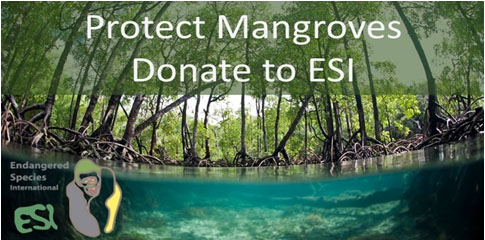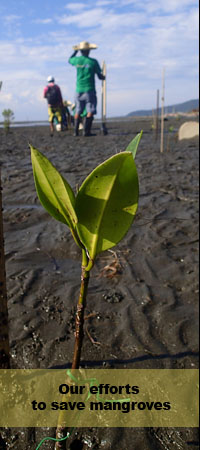|
Intertidal mangrove forests dominate the world's tropical and subtropical coasts, paralleling the geographical distribution of coral reefs. They survive in substrate salinities ranging from fresh water alongside rivers to hypersaline ponds and mudflats. Mangrove plants are pioneer as well as mature-phase species. They not only help form these environments, they create habitats for a diverse and characteristic community of organisms, including numerous mangrove-dependent organisms.
Mangrove Forests are one of the world's threatened major tropical ecosystems. Around 40 percent of the area of mangrove forests has been lost in the past three decades, losses that exceed those for tropical rain forests and coral reefs, two other well-known threatened natural environments. Approximately 75% of world's mangroves are found in just 15 countries, and only 8 % are protected under the existing protected areas.
Mangroves prevent coastal erosion by stabilizing sediments, furnish nursery and spawning areas for commercially important coastal fish and shellfish species, and provide stopover sites for migratory birds, fish, and mammals. Mangrove forests are also habitats for a diversity of species that have considerable importance, both economically and ecologically. They include approximately 16 families and 40 to 50 species of trees. The fauna of mangroves includes fish and shellfish taxa that support subsistence fishing, as well as rare endemic proboscis monkeys in Borneo, scarlet ibis, the vulnerable straight-billed woodcreeper in Trinidad, threatened Bengal tigers in India and Bangladesh, rare Bulbophyllum and other orchids in Singapore, endangered manatees in Florida, and many other key species. Mangroves also provide a last refuge for wildlife species that have lost their original habitat due to human destruction. Examples include the yellow-shouldered blackbird (Agelaius xanthomus) and the Philippine cockatoo (Cacatua haematuropygia). While the primary habitat for these species had been inland forests, they are currently restricted to mangroves, and presumably could have gone extinct had they not been able to use mangroves as a last refuge. Further, 48 bird, 14 reptile, 1 amphibian (the mangrove frog Eleutherodactylus caribe endemic to Haiti), and 6 mammal species are restricted to mangroves, the majority of which are found in Asia and Australia. Further, more than 40% of assessed mangrove-endemic vertebrates are globally threatened.
As climate change threatens to increase the frequency and severity of storms, mangroves provide a great defense. Although mangrove forests cover just 0.1 percent of our planet’s land surface, they store more carbon than any other type of forest. In fact, mangroves store 10 times more carbon than terrestrial forests, and twice as much as salt marshes.
Despite their uncommon resilience, mangrove forests are under threat and often overlooked for the vital resource they are. It is time to start working toward some serious mangrove appreciation. By protecting and restoring mangroves, we can help protect the future of our planet.
ESI work for mangroves
We plant thousands of mangrove trees each year mostly in Southeast Asia. Our planting occurs in soft sediments protected from extreme wave action, such as in the deltas of large rivers and estuaries and on the leeward side of barrier islands. After planting, another important step in restoration involves monitoring and learning from our work to make sure our projects are successful and long-lasting;
We collect and grow the ‘right mix’ of species of mangrove trees for future plantation as some mangroves tolerate greater salt water flooding than others (an important consideration with sea level rise due to climate change). The diversity of tree species in an ecosystem influences its health, diversity, resilience and provision of ecosystem services;
We support and create mangrove protected areas in Asia and Africa. Well-managed protected areas are the most effective way to safeguard mangrove forests;
We involve and empower local communities at every stage of our conservation mangrove projects.
We train local communities on mangrove ecology, planting, caring, and monitoring;
Finally, our work is not driven by photo opportunities and media coverage. Instead, a sound, science-based plan, strong local community involvement, and passion for mangrove forest lead to mangrove conservation success.

|











